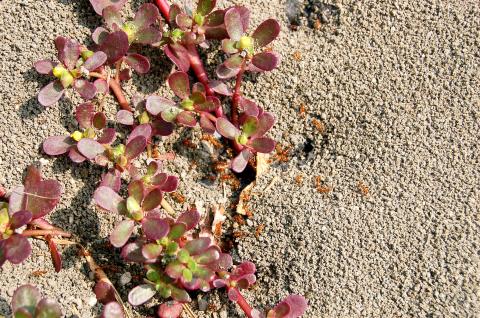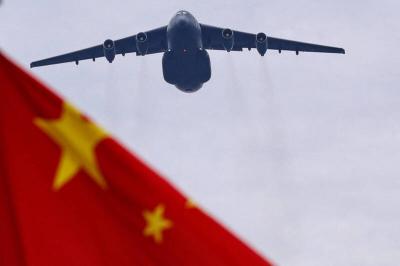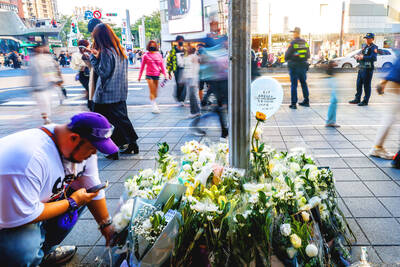The total area in Taiwan affected by exotic red fire ants has increased by nearly 50 percent since 2003, but despite the growing infestation, the government budget for pest control was cut from last year’s NT$40 million (US$1.36 million) to NT$20 million this year.
Listed among the world’s top 100 most-invasive species, the ants, native to South America, were discovered in Taiwan in 2003 and have alarmed residents by quickly spreading through urban areas in Greater Taipei, Taoyuan, Hsinchu, Miaoli and Chiayi counties.
The ants not only pose a serious threat to Taiwanese ecology, but the necrotizing alkaloid in their venom can cause a blister or pustule — which earned them their name — that can cause a person to go into shock or can even be fatal if the person is allergic.

Photo: Chen Tsan-kun, Taipei Times
In 2004, the Council of Agriculture (COA) established a national red exotic fire ant prevention center tasked with containing the spread of the ants within a 36,000-hectare radius, but last year the center increased its containment area to 55,000 hectares.
According to the center, in 2007 there were 1,619 known locations of red fire ant activity, but last year known locations had increased to 2,440. The center said that in five years, Hsinchu County alone had seen an increase from 23 locations to 244, while New Taipei City (新北市) saw a 250 percent increase in ant activity, going up from 177 locations to 453.
National red fire ant prevention center director Huang Rong-nan (黃榮南) said that when the ants were accidentally introduced to Australia in 2001, the total infected area stood at about 60,000 to 70,000 hectares. The Australian government assigned a team of 600 people to combat the pests, and even used planes to spray a pesticide to contain them.
Taiwan, on the other had, has insufficient manpower to contain the ants, he said.
Huang Chi-sen (黃基森), a professor at National Taipei University of Education’s Program of Environmental Education and Resources, has been monitoring the activities of the ants for many years. Huang said that because of Taiwan’s geography, prevention and control of the ants would prove to be difficult.
“Now that the funding has been slashed, I’m afraid that it will be increasingly difficult to contain the ants,” he said.
The government should not give up, Huang said, because between 7 million and 8 million people live in the infested area. Huang said that the US suffers US$5 billion in losses per year because of the ants.
In response to why the COA was slashing funding for ant prevention, Fei Wen-chi (費雯綺) of the Bureau of Animal and Plant Health Inspection and Quarantine said the budget cut was the result of financial troubles at the central government.
Despite the financial difficulties, the budget was still enough to ensure high-level prevention and containment, Fei said, adding that the council would employ alternative methods to contain the ants.
“We have adjusted our strategies for this year,” she said. “While Taoyuan County will be under full prevention and containment as a ‘heavy disaster’ area, the bureau will treat other infested areas as hotspots and adjust its strategy accordingly.”
Translated by Jake Chung, staff writer

Beijing could eventually see a full amphibious invasion of Taiwan as the only "prudent" way to bring about unification, the US Department of Defense said in a newly released annual report to Congress. The Pentagon's "Annual Report to Congress: Military and Security Developments Involving the People's Republic of China 2025," was in many ways similar to last year’s report but reorganized the analysis of the options China has to take over Taiwan. Generally, according to the report, Chinese leaders view the People's Liberation Army's (PLA) capabilities for a Taiwan campaign as improving, but they remain uncertain about its readiness to successfully seize

Taiwan is getting a day off on Christmas for the first time in 25 years. The change comes after opposition parties passed a law earlier this year to add or restore five public holidays, including Constitution Day, which falls on today, Dec. 25. The day marks the 1947 adoption of the constitution of the Republic of China, as the government in Taipei is formally known. Back then the Chinese Nationalist Party (KMT) governed China from Nanjing. When the KMT, now an opposition party in Taiwan, passed the legislation on holidays, it said that they would help “commemorate the history of national development.” That

HORROR STORIES: One victim recounted not realizing they had been stabbed and seeing people bleeding, while another recalled breaking down in tears after fleeing A man on Friday died after he tried to fight the knife-wielding suspect who went on a stabbing spree near two of Taipei’s busiest metro stations, Taipei Mayor Chiang Wan-an (蔣萬安) said. The 57-year-old man, identified by his family name, Yu (余), encountered the suspect at Exit M7 of Taipei Main Station and immediately tried to stop him, but was fatally wounded and later died, Chiang said, calling the incident “heartbreaking.” Yu’s family would receive at least NT$5 million (US$158,584) in compensation through the Taipei Rapid Transit Corp’s (TRTC) insurance coverage, he said after convening an emergency security response meeting yesterday morning. National

Taiwan has overtaken South Korea this year in per capita income for the first time in 23 years, IMF data showed. Per capita income is a nation’s GDP divided by the total population, used to compare average wealth levels across countries. Taiwan also beat Japan this year on per capita income, after surpassing it for the first time last year, US magazine Newsweek reported yesterday. Across Asia, Taiwan ranked fourth for per capita income at US$37,827 this year due to sustained economic growth, the report said. In the top three spots were Singapore, Macau and Hong Kong, it said. South